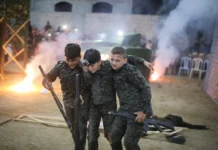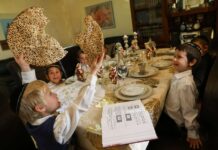Barbara Kratchman, active in many organizations throughout the Jewish community, and Mary Romaya, active in many organizations throughout the Chaldean community, grew up in the same northwest Detroit neighborhood.
They rode their bikes along the same blocks, near Seven Mile and Livernois, and they frequented the same stores and restaurants along what was known in the 1960s as the Avenue of Fashion along Livernois. Because they didn’t go to the same schools, the two believe, they never met as youngsters.
As adults, the two met through the Chaldean/Jewish Building Bridges Initiative, established by the Detroit Jewish News and the Chaldean News, and they became friends serving as co-chairs of the Arts and Culture Committee of that group.
The women got together informally and talked about their efforts together, and they shared information about special projects in each of their respective cultural communities. Kratchman took a deep interest in a museum Romaya was developing, and the interest continued after Building Bridges deactivated.
Romaya, executive director of the Chaldean Cultural Center housed at the Shenandoah Country Club in West Bloomfield, was raising funds and finding experts to establish a state-of-the-art facility calling attention to Chaldean history with a special focus on Chaldean achievements as immigrants left Iraq and established themselves in Metro Detroit.
After 10 years of work, the Chaldean Museum — the first in the world — is open, and members of the Building Bridges Initiative reconvened with a special tour and get-together on Oct. 4. The museum is open to the public on Friday afternoons although arrangements can be made for group tours at other times.
“We are covering more than 5,000 years of history with displays filling five galleries,” Romaya explains. “Visitors from communities that are not Chaldean will recognize cultural elements that are shared and learn more about the Chaldean people with respect to their heritage as part of the Catholic religion.
“Jewish visitors will see an ancient document written in Hebrew and connections shown among Aramaic languages. They will note that reading was done right to left for languages related to Hebrew,” she adds.
“The technology will allow for some hands-on experiences, and the environment of each gallery reflects that specific time in history; for example, the Jerusalem section has been built with stone. The floors hold dates showing the involved time frames as guests walk through each section.”
The first gallery, “Ancient Mesopotamia,” captures history back to the Sumerians. Authentic replicas and original artifacts purchased from around the world represent the experiences of that era.
The next gallery, “Faith and Church,” explores the beginning of the Chaldean Catholic Church of the East. There are liturgical manuscripts and church adornments. In a media presentation, prayers are recited in Aramaic so that the sounds of the language are experienced.
“Chaldean Village Life” has life-size mannequins shown carrying out day-to-day activities in realistic settings. “Journey to America” shows immigration documents and spotlights those who became entrepreneurs. A small replica of a Chaldean-owned grocery store of the 1930s in Detroit shows only American products as assimilation takes hold.
In “Chaldeans Today,” a large video presentation introduces people who value their heritage along with their places in America.
“I had the pleasure of watching how this museum developed over time,” Kratchman says. “Because of the initiative, we found people who are neighbors, and they became our lasting friends. With the museum, we can gain more insight into understanding our similarities.”
As Romaya was planning the museum, she sought advice from Stephen Goldman, then executive director of the Holocaust Memorial Center in Farmington Hills. She had visited the center and was impressed with the way personal stories were told using a multitude of media.
“He explained the way panels should look, and he recommended antiquity dealers,” Romaya says. “He told me about giving personal tours and the importance of training docents. There also was advice about conducting oral histories. All of that has been very valuable to us.”
The Chaldean Museum was developed with the help of Saylor + Sirola, New York exhibition designers specializing in boutique museums. Special effects and segments were handled by Sana Media in New York and LifeFormations in Cincinnati. Funding came from individuals, organizations and businesses.
“I’ve already brought two groups of Jewish women to see this museum,” says Jeannie Weiner, who was at the helm of the Social Action Committee of the Building Bridges Initiative. “It’s as fine a museum as you could find anywhere. It’s sophisticated with hands-on information.
“I think it’s important to learn about other cultures just as I think every group should visit the Holocaust Memorial Center.
“I was especially fascinated by learning about the ancient code of laws — some laws pertinent today and others very brutal as a reflection of the times. I encourage everyone to go and see all that the museum offers.”
























